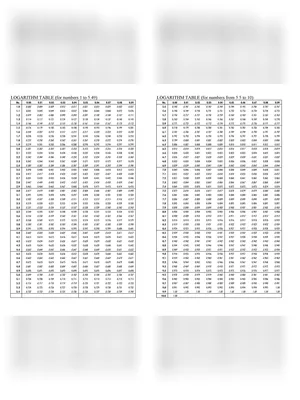Here we provide a direct download link to the ‘Log Table Elements Complete Chart PDF’. You can find the download button of the attachment pdf at the end of this article. For information, we have provided – ‘Log Table Elements Complete Chart English’ details like PDF size, PDF language, and PDF demo.
Log Table Elements PDF Free Download

Log Table Elements
Sometimes, a numerical expression may involve multiplication, division, or rational powers of larger numbers. Logarithms are very useful for such calculations.
They help us in doing difficult calculations easily. In chemistry, logarithmic values are needed to solve problems in chemical kinetics, thermodynamics, electrochemistry, etc.
We’ll first introduce the concept, discuss the laws that must be followed in working with logarithms, and then apply the technique. A number of problems to show how it simplifies difficult calculations.
We know that
2³ = 8, 3² = 9, 5³ = 125, 7⁰ = 1
Another way of stating the same fact is the logarithm of b to base a is m.
If for a positive real number a, a # 1
we say that m is the logarithm of b to the base a.
We write this as log b = m.
In general, for a positive real number a, and a rational number m, let a” = b. where b is a real number. In other words the mth power of base a is b. a = b. published
Laws of Logarithms
In the following discussion, we shall take logarithms to any base a, (a > 0 and a # 1)
First Law: loga (mn) = logam + logan
Proof: Suppose that logam = x and logan = y
Then a m, a = n
Hence mn = a*.a = axty
It now follows from the definition of logarithms that
loga (mn) = x + y = loga m loga n
Second Law: loga (m/n) = logam – logan
How to Use the Log Table?
The procedure is given below to find the log value of a number using the log table. First, you have to know how to use the log table. The log table is given for the reference to find the values.
Step 1: Understand the concept of the logarithm. Each log table is only usable with a certain base. The most common type of logarithm table is used is log base 10.
Step 2: Identify the characteristic part and mantissa part of the given number. For example, if you want to find the value of log10 (15.27), first separate the characteristic part and the mantissa part.
Characteristic Part = 15
Mantissa part = 27
Step 3: Use a common log table. Now, use row number 15 and check column number 2 and write the corresponding value. So the value obtained is 1818.
Step 4: Use the logarithm table with a mean difference. Slide your finger in the mean difference column number 7 and row number 15, and write down the corresponding value as 20.
Step 5: Add both the values obtained in step 3 and step 4. That is 1818+20= 1838. Therefore, the value 1838 is the mantissa part.
Step 6: Find the characteristic part. Since the number lies between 10 and 100, (101 and 102), the characteristic part should be 1.
Step 7: Finally combine both the characteristic part and the mantissa part, it becomes 1.1838.
| Author | – |
| Language | English |
| No. of Pages | 1 |
| PDF Size | 0.05 MB |
| Category | Mathematics |
Alternative Link For Download Log Table Chart
Related PDFs
Log Table Elements Book PDF Free Download
